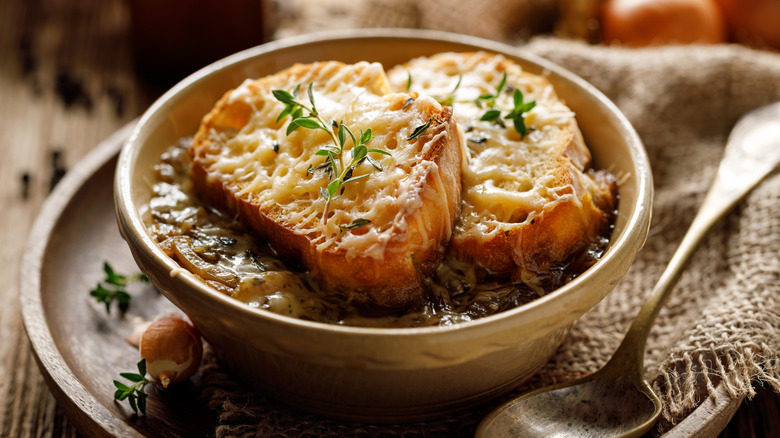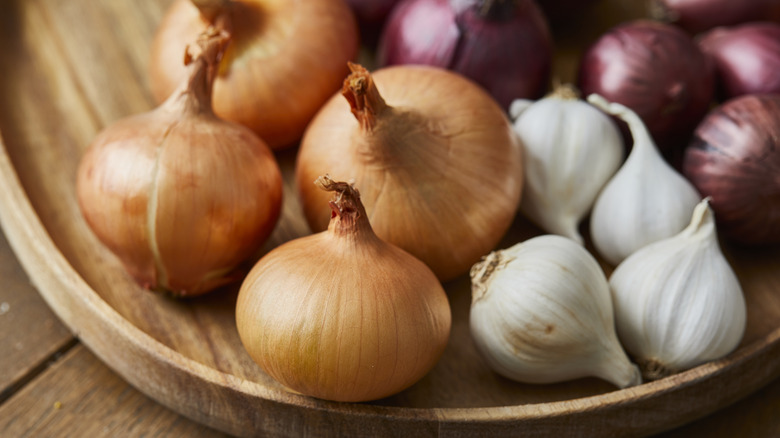The Absolute Best Onion Variety For French Onion Soup
Name the top five indulgent, comforting, old-school meals — and rustic, soothing, savory French onion soup should have a spot on that list. Be it the wholesome broth, the sweet caramelized onions, or the crispy yet ooey-gooey slice of bread with melted stringy cheese topping off the whole creation, the perfection is unparalleled. While there's plenty of room for modifications with the way you make your soup (such as the bread and cheese you choose), it's a simple fact that certain types of onions reign supreme. Of your options — ranging from red to white to sweet to yellow, to even shallots — the jury is in, and it's the accessible, hardworking, regular yellow onion that should be your first pick. Though other varieties will work, most agree that this imparts French onion soup with the ideal sweet and savory flavor that's not too overpowering or too weak.
French onion soup might be a treat that you often order in, but it's actually surprisingly easy to cook at home for a comforting warming weeknight meal or a dish to impress guests coming over for dinner. You'll find many recipes for French onion soup with varying cook times, types of bread and cheese, or even vegan variations. Whichever recipe you're following, be sure to stock up on yellow onions for the best possible final result.
Not all onions are created equal
You're not alone if the array of onion types at the grocery store — white, yellow, red, or sweet — has you a little fuzzy on the differences and best uses for each. In general, remember this: White onions tend to be milder and less harsh in taste than their yellow counterparts. Then you have the yellow-skinned onions (sometimes called brown), which are by far the most common types of onions. The basic yellow variety is stronger and has more of a kick, but when it cooks down, it mellows out into ideal sweetness, which makes it the perfect candidate for French onion soup. Yellow onions are also heartier with a higher starch content, allowing them to withstand the hours of cooking required.
The sweet variety — under the umbrella in which Vidalia and other varieties fall — is milder and lacks the sharpness of their white or yellow counterparts, as the name suggests. These, or a white onion, are your best bets for using in salads and sandwiches. And then there's red, which typically provides the most sharpness and the strongest flavor. While most agree that yellow onions have the perfect not-too-strong, not-too-sweet flavor and hearty texture for cooking down in a soup, you can always try experimenting with different types. Or, try a mix of onions for a rainbow of colors and varying flavors.
Caramelizing yellow onions is the key for a great soup
With a dish as onion-forward as French onion soup, not only does the quality matter, but the quantity. And don those eye goggles or be prepared to get weepy, because you're going to be chopping a lot of onions. You'll finely slice at least three to four onions for a recipe, depending on how big of a batch you're making. The first and most important step to making that rich trademark broth is perfectly caramelizing the onions. The ideal level of caramelization can be (and is) endlessly debated. Achieving a perfectly golden dark — but not too dark — color is the absolute key to infusing your broth with the strong and sweet (but never bitter) taste that makes French onion soup what it is.
Cook too long and the soup can have a distinctly burnt, charred flavor that no amount of spices or ingredient adjustments can mask. Undercook the onions and you likely won't achieve the true caramelization that French onion soup calls for. This takes time and attention, meaning you won't want to walk away from the stove for too long. But when ordinary onions are given time to slowly sweeten and darken, the time spent in the kitchen is well worth the payoff of this perfectly cozy, warming, and savory soup.
Static Media owns and operates Chowhound and Tasting Table.


